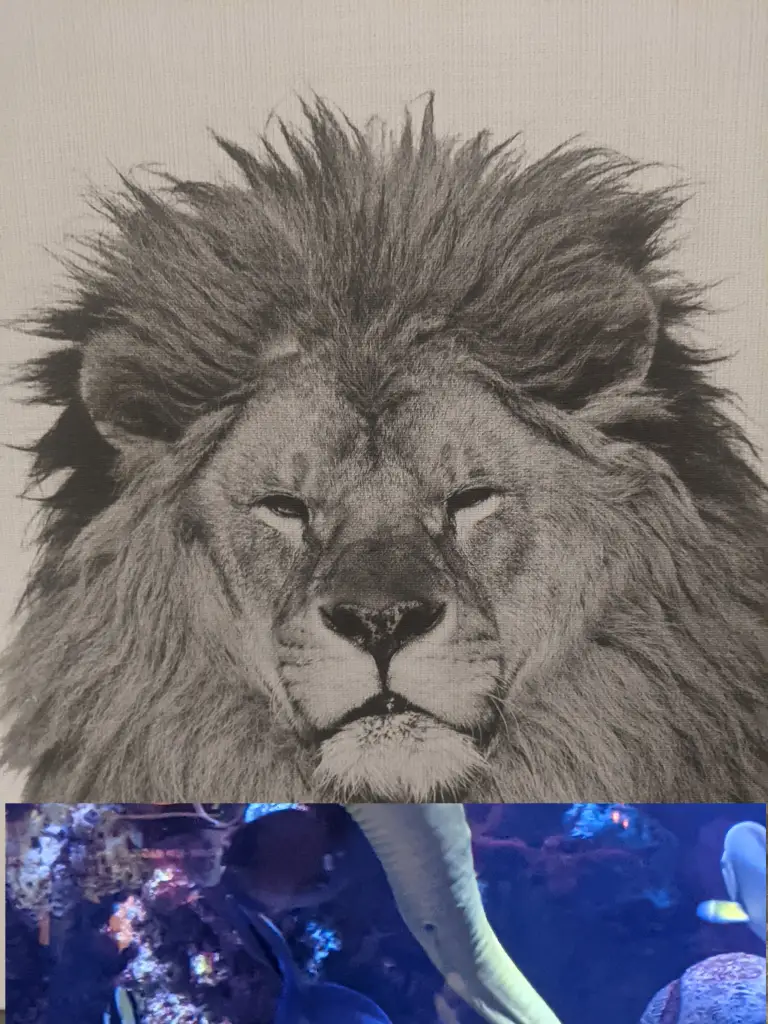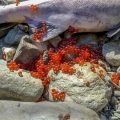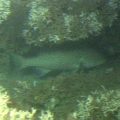Groupers are numerous species of largemouth and heavy-body fishes in the subfamily of Epinephelinae of the family Serranidae. When Groupers eat lionfish, they approach its head-on and suddenly swallow the lionfish, but eating a live lionfish needs some certain technique. Whenever the lionfish assumes any attack from a predator, he splays out all its 18 venomous spines. Groupers swallow the lionfish headfirst so its venomous spine cannot affect him.

Why are lionfish a problem?
Lionfish are a terrible problem in the Western Atlantic Ocean, the Caribbean Sea, and the Gulf of Mexico. One thing is certain: the lionfish invasion is probably the worst man-made ecological disaster ever witnessed and has yet to play out completely. Lionfish likes to prey on crustaceans, mollusks, and reef fish with species like the scamp grouper, which are essential commercial fish in the US. There are no natural predators in these waters, and lionfish numbers are increasing at an uncontrolled rate.
Lionfish can eat over half size of their own body as much as it fits into their mouths. Their stomach can enlarge up to 30 times the normal volume and fill up to as per ability. They also eat mollusks, shrimp, crabs, octopuses, squid, etc. Lionfish strike and gulp down dozens of whole fish at a lightning-fast speed. Science has revealed that a single lionfish can reduce marine species by 80% to 90% within just 5 weeks.
Are lionfish venomous?
The lionfish might be venomous but not poisonous. They have 18 pelvic, dorsal, and anal fin spines containing venom that reason for pain, nausea, and even paralysis. Lionfish insert venom through spines, but they don’t have any other venom sources in their body except their fins. That venom is located at the tip of the spines and its needle-sharp fins. The lionfish is covered with beautiful fins, but not all fins are with venom if anyone affected by lionfish venom can use hot water for immediate aid.
Does it hurt fish to eat venomous Lionfish?
The Lionfish sting is dangerous, and it has seen many people cry with this sting, but how do other fish eat them without suffering? The answer is that fish are mainly cold-blooded, and venom does not affect a warm-blooded animal.
For the same reason, it has been found that venomous snakes can feed cold-blooded prey and tend to have stronger venom than eating warm-blooded food. Most importantly, remember that lionfish never use their venom to attack or harm. Rather, they use it for defense.
Do lionfish attack people?
We have never found any story in which a lionfish has offensively attacked anyone or is aggressive towards any human. Most certainly, it injures people out of self-defense or by accident. Diversly are mostly stung by lionfish while hunting them.
Divers are also prone to be envenomated when they try to put a lionfish into a bag or storage device and get hurt while they are too close to the lionfish. The underwater photographers were hurt because they did not see a lionfish when too close to them and might think it was a docile fish. The lionfish managed to get spun lightning fast after shaking the body.
What kind of fish eat lionfish?
The lionfish is a venomous fish and member of the Scorpaenidae family, which means scorpionfish, because of the venomous mucus in their sharp spines. They are characterized by their unique appearance and are easily spotted amid the rocks and reefs where they are commonly found. Their 18-long venomous spines are the most defining features.
Lionfish are mostly found in the Indo-Pacific and the Red Sea. There have been some predators that catch and eat lionfish for millennia. Those predators are as follows:
- Sharks
- Eels
- Grouper
- Cornet fish
- Frogfish
- Scorpionfish
What do Groupers eat?
Grouper fish are usually found under deep seawater. Groupers walked in the teleost and had a strong body with largemouth. They are fast at swimming. The groupers catch their prey by blending in with others and ambush their catch with a quick dart and a snap of their teeth.
Groupers sharpened rows of teeth make it easy to grab and keep prey in their mouths to prevent escape. The fish do not chew their prey because they do not have any teeth. Their wide-sized mouth creates negative pressure that sucks in fish and prey. Groupers can swallow their whole food easily.
Goliath Grouper prefer to eat crustaceans (in particular spiny lobsters, shrimps, and crabs) and small baitfish than larger fish. However, they habitually also eat fish, octopuses, and crustaceans. Groupers also feed various fish species, parrotfish, stingrays, young sea turtles, and octopuses. Sometimes large Goliath Grouper feasts on barracudas and sharks, including large size lemon sharks.
Can a grouper eat a human?
The Grouper fish weighs up to 800 Ib and height up to 8 feet, stalks its prey from the depth of the Atlantic Ocean. In the ocean, their lack of fear has permitted humans to get close to them and catch Grouper at dangerously low levels. As a result, the critically endangered groupers are down by 80% over time.
This opportunistic predator can spend hours in dark holes and wait for the right moment to eat everything in its path. The Grouper lures to fish, just opening his mouth. The predator could eat you alive if you linger for too long in his area. Its huge mouth opening is so huge that the negative pressure exerts everything inside the Grouper’s mouth.
Many people know groupers as “gentle giants,” and it’s best to stay away from fully grown goliath groupers. Grouper height is near about 8 feet and weighs about 800 pounds. Yes, they can eat a human if they want to. However, groupers are very friendly with humans and not threatened in general.
Where can Groupers be found?
The Grouper is mostly found in shallow tropical waters among artificial reefs and coral areas. This range covers the Gulf of Mexico and Florida in the United States, the Bahamas, the Caribbean, and the major area of the Brazilian coast.
Occasionally the goliath grouper is found on the coast of New England in Massachusetts and Maine. Goliath Grouper is also found in the eastern Atlantic Ocean on the coast of Africa from the Congo to Senegal.
Conclusion
If you’re a grouper that loves to hunt, there is hope for you. If not, maybe we can all learn from your example and take action against the lionfish population before it’s too late.











